- DTC judgment completed
- System normal
| Last Modified: 05-13-2024 | 6.11:8.1.0 | Doc ID: RM100000001HSYW |
| Model Year Start: 2020 | Model: Corolla | Prod Date Range: [03/2019 - 11/2022] |
| Title: 2ZR-FAE (ENGINE CONTROL): SFI SYSTEM: P0031,P0032,P101D; Oxygen (A/F) Sensor Heater Control Circuit Low (Bank 1 Sensor 1); 2020 - 2023 MY Corolla [03/2019 - 11/2022] | ||
|
DTC |
P0031 |
Oxygen (A/F) Sensor Heater Control Circuit Low (Bank 1 Sensor 1) |
|
DTC |
P0032 |
Oxygen (A/F) Sensor Heater Control Circuit High (Bank 1 Sensor 1) |
|
DTC |
P101D |
A/F Sensor Heater Circuit Performance Bank 1 Sensor 1 Stuck ON |
DESCRIPTION
The air fuel ratio sensor generates a voltage* that corresponds to the actual air fuel ratio. This sensor voltage is used to provide the ECM with feedback so that it can control the air fuel ratio. The ECM determines the deviation from the stoichiometric air fuel ratio level, and regulates the fuel injection duration. If the air fuel ratio sensor malfunctions, the ECM is unable to control the air fuel ratio accurately.
The air fuel ratio sensor is a planar type and is integrated with the heater, which heats the solid electrolyte (zirconia element). This heater is controlled by the ECM. When the intake air volume is low (the exhaust gas temperature is low), a current flows into the heater to heat the sensor, in order to facilitate accurate oxygen concentration detection. In addition, the sensor and heater portions are a narrow type. The heat generated by the heater is conducted to the solid electrolyte through the alumina, and therefore sensor activation is accelerated.
In order to obtain a high purification rate of the carbon monoxide (CO), hydrocarbon (HC) and nitrogen oxide (NOx) components in the exhaust gas, a three-way catalytic converter is used. For the most efficient use of the three-way catalytic converter, the air fuel ratio must be precisely controlled so that it is always close to the stoichiometric level.
*: Value changes inside the ECM. Since the air fuel ratio sensor is a current output element, the current is converted into a voltage inside the ECM. Any measurements taken at the air fuel ratio sensor or ECM connectors will show a constant voltage.
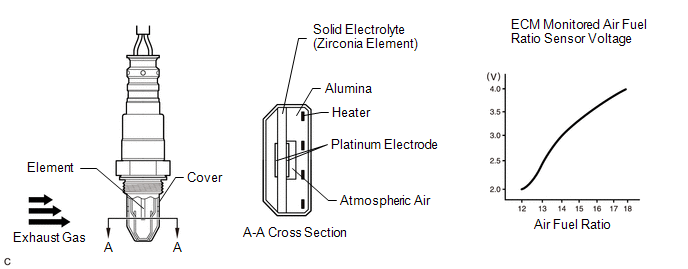
HINT:
- When any of these DTCs are stored, the ECM enters fail-safe mode. The ECM turns off the air fuel ratio sensor heater in fail-safe mode. Fail-safe mode continues until the ignition switch is turned off.
- Although the DTC titles say oxygen sensor, these DTCs relate to the air fuel ratio sensor.
-
The ECM has a pulse width modulated control circuit to adjust the current through the heater. The air fuel ratio sensor heater circuit uses a relay on the +B side of the circuit.
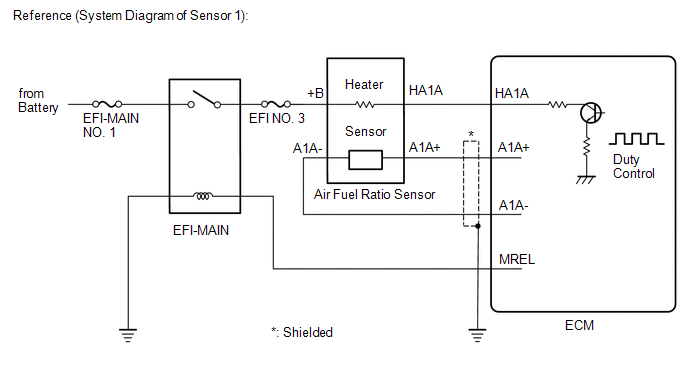
|
DTC No. |
Detection Item |
DTC Detection Condition |
Trouble Area |
MIL |
Memory |
Note |
|---|---|---|---|---|---|---|
|
P0031 |
Oxygen (A/F) Sensor Heater Control Circuit Low (Bank 1 Sensor 1) |
Air fuel ratio sensor heater current is less than 0.8 A, even when the air fuel ratio sensor heater duty cycle is 30% or higher (1 trip detection logic). |
|
Comes on |
DTC stored |
DTC for Mexico Models - Applies |
|
P0032 |
Oxygen (A/F) Sensor Heater Control Circuit High (Bank 1 Sensor 1) |
Air fuel ratio sensor heater current reaches the high limit (1 trip detection logic). |
|
Comes on |
DTC stored |
DTC for Mexico Models - Applies |
|
P101D |
A/F Sensor Heater Circuit Performance Bank 1 Sensor 1 Stuck ON |
Air fuel ratio sensor heater current is higher than the specified value while the heater is not operating (1 trip detection logic). |
|
Comes on |
DTC stored |
DTC for Mexico Models - Applies |
MONITOR DESCRIPTION
The ECM uses information from the air fuel ratio sensor to regulate the air fuel ratio and keep it close to the stoichiometric level. This maximizes the ability of the three-way catalytic converter to purify the exhaust gases.
The air fuel ratio sensor detects oxygen levels in the exhaust gas and transmits the information to the ECM. The inner surface of the sensor element is exposed to the outside air. The outer surface of the sensor element is exposed to the exhaust gas. The sensor element is made of platinum-coated zirconia and includes an integrated heating element.
The zirconia element generates a small voltage when there is a large difference in the oxygen concentrations between the exhaust gas and outside air. The platinum coating amplifies this voltage generation.
The air fuel ratio sensor is more efficient when heated. When the exhaust gas temperature is low, the sensor cannot generate useful voltage signals without supplementary heating. The ECM regulates the supplementary heating using a duty-cycle approach to adjust the average current in the sensor heater element. If the heater current is outside the normal range, the signal transmitted by the air fuel ratio sensor becomes inaccurate. As a result, the ECM is unable to regulate the air fuel ratio properly.
When the current in the air fuel ratio sensor heater is outside the normal operating range, the ECM interprets this as a malfunction in the sensor heater and stores a DTC.
MONITOR STRATEGY
|
Related DTCs |
P0031: Air fuel ratio sensor heater range check (low current) P0032: Air fuel ratio sensor heater range check (high current) P101D: Air fuel ratio sensor performance |
|
Required Sensors/Components (Main) |
Air fuel ratio sensor heater |
|
Required Sensors/Components (Related) |
- |
|
Frequency of Operation |
Continuous |
|
Duration |
10.24 seconds: P0032 10 seconds: P0031 1 second: P101D |
|
MIL Operation |
Immediate |
|
Sequence of Operation |
None |
TYPICAL ENABLING CONDITIONS
P0031
|
All of the following conditions are met |
- |
|
Battery voltage |
10.5 V or higher |
|
Time after heater on |
5 seconds or more |
|
Active heater off control |
Not operating |
|
Active heater on control |
Not operating |
|
Air fuel ratio sensor heater performance fail (P101D) |
Not detected |
|
Output duty cycle |
30% or higher |
P0032
|
Monitor runs whenever the following DTCs are not stored |
None |
|
All of the following conditions are met |
- |
|
Battery voltage |
10.5 V or higher |
|
Time after heater on |
5 seconds or more |
|
Active heater off control |
Not operating |
|
Active heater on control |
Not operating |
|
Output duty cycle |
Higher than 0% |
P101D
|
All of the following conditions are met |
10 seconds or more |
|
Battery voltage |
10.5 V or higher |
|
Air fuel ratio sensor heater low current fail (P0031) |
Not detected |
|
Output duty cycle |
Less than 60% |
|
Command to heater output |
Off |
|
Active heater off control |
Not operating |
|
Active heater on control |
Not operating |
TYPICAL MALFUNCTION THRESHOLDS
P0031
|
Heater on current |
Less than 0.8 A |
P0032
|
Both of the following conditions are met |
- |
|
Command to heater output |
ON |
|
Heater current detected by heater monitor IC |
14 A or higher |
P101D
|
Both of the following conditions are met |
- |
|
Heater current detected by heater monitor IC |
14 A or higher |
|
Heater off current |
Higher than 11 A |
COMPONENT OPERATING RANGE
P0031
|
Heater on current |
0.8 A or higher |
P0032
|
Both of the following conditions are met |
- |
|
Command to heater output |
ON |
|
Heater current detected by heater monitor IC |
Less than 14 A |
P101D
|
Heater off current |
11 A or less |
CONFIRMATION DRIVING PATTERN
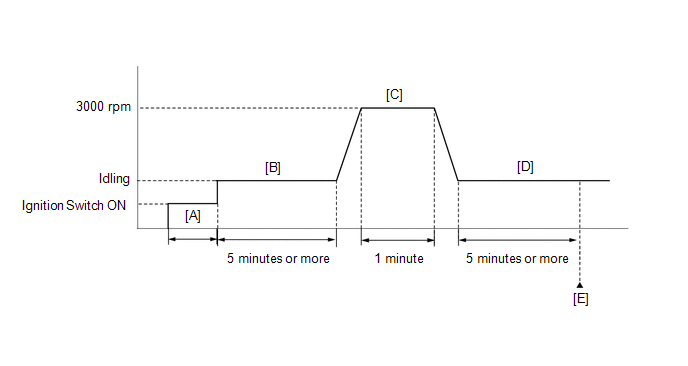
- Connect the Techstream to the DLC3.
- Turn the ignition switch to ON.
- Turn the Techstream on.
- Clear the DTCs (even if no DTCs are stored, perform the clear DTC procedure).
- Turn the ignition switch off and wait for at least 30 seconds.
- Turn the ignition switch to ON [A].
- Turn the Techstream on.
- Start the engine and idle it for 5 minutes or more [B].
- With the vehicle stationary, depress the accelerator pedal and maintain an engine speed of 3000 rpm for 1 minute [C].
- Idle the engine for 5 minutes or more [D].
- Enter the following menus: Powertrain / Engine and ECT / Trouble Codes [E].
-
Read the pending DTCs.
HINT:
- If a pending DTC is output, the system is malfunctioning.
- If a pending DTC is not output, perform the following procedure.
- Enter the following menus: Powertrain / Engine and ECT / Utility / All Readiness.
- Input the DTC: P0031, P0032 or P101D.
-
Check the DTC judgment result.
Techstream Display
Description
NORMAL
ABNORMAL
- DTC judgment completed
- System abnormal
INCOMPLETE
- DTC judgment not completed
- Perform driving pattern after confirming DTC enabling conditions
N/A
- Unable to perform DTC judgment
- Number of DTCs which do not fulfill DTC preconditions has reached ECU memory limit
HINT:
- If the judgment result shows NORMAL, the system is normal.
- If the judgment result shows ABNORMAL, the system has a malfunction.
- If the judgment result shows INCOMPLETE or N/A, perform steps [B] through [E] again.
-
If no pending DTC is output, perform a universal trip and check for permanent DTCs.
HINT:
- If a permanent DTC is output, the system is malfunctioning.
- If no permanent DTC is output, the system is normal.
WIRING DIAGRAM
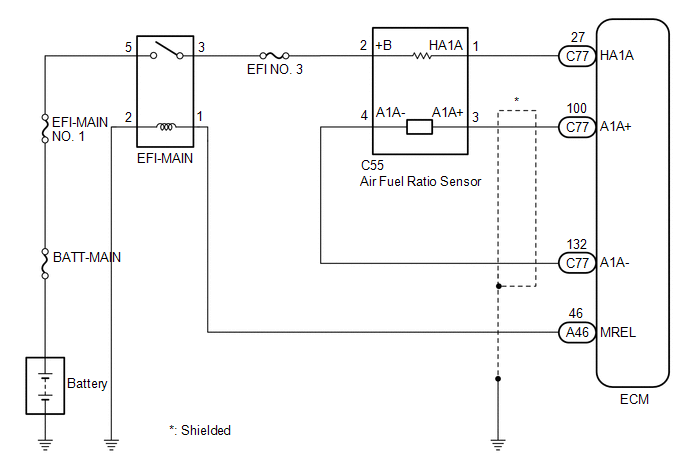
CAUTION / NOTICE / HINT
NOTICE:
Inspect the fuses for circuits related to this system before performing the following procedure.
HINT:
- Refer to "Data List / Active Test" [A/F Heater Duty B1S1].
- Sensor 1 refers to the sensor closest to the engine assembly.
- Sensor 2 refers to the sensor farthest away from the engine assembly.
-
Change the fuel injection volume using the Control the Injection Volume for A/F Sensor function provided in the Active Test and monitor the air fuel ratio sensor output voltage (Click here
![2020 - 2023 MY Corolla [03/2019 - 11/2022]; 2ZR-FAE (ENGINE CONTROL): SFI SYSTEM: P0136-P0139,P013A; O2 (A/F) Sensor Circuit (Bank 1 Sensor 2)+](/t3Portal/stylegraphics/info.gif) ). If the sensor output voltage does not change (almost no reaction) while performing the Active Test, the sensor may be malfunctioning.
). If the sensor output voltage does not change (almost no reaction) while performing the Active Test, the sensor may be malfunctioning.
- Read Freeze Frame Data using the Techstream. The ECM records vehicle and driving condition information as Freeze Frame Data the moment a DTC is stored. When troubleshooting, Freeze Frame Data can help determine if the vehicle was moving or stationary, if the engine was warmed up or not, if the air fuel ratio was lean or rich, and other data from the time the malfunction occurred.
PROCEDURE
|
1. |
INSPECT AIR FUEL RATIO SENSOR (HEATER RESISTANCE) |
(a) Inspect the air fuel ratio sensor.
HINT:
Perform "Inspection After Repair" after replacing the air fuel ratio sensor.
| NG |

|
|
|
2. |
CHECK TERMINAL VOLTAGE (POWER SOURCE OF AIR FUEL RATIO SENSOR) |
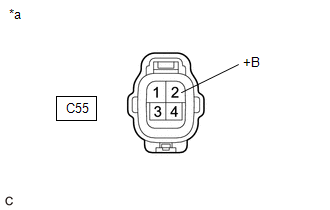
|
*a |
Front view of wire harness connector (to Air Fuel Ratio Sensor) |
(a) Disconnect the air fuel ratio sensor connector.
(b) Turn the ignition switch to ON.
(c) Measure the voltage according to the value(s) in the table below.
Standard Voltage:
|
Tester Connection |
Condition |
Specified Condition |
|---|---|---|
|
C55-2 (+B) - Body ground |
Ignition switch ON |
11 to 14 V |
| NG |

|
REPAIR OR REPLACE HARNESS OR CONNECTOR (AIR FUEL RATIO SENSOR - EFI-MAIN RELAY) |
|
|
3. |
CHECK HARNESS AND CONNECTOR (AIR FUEL RATIO SENSOR - ECM) |
(a) Disconnect the air fuel ratio sensor connector.
(b) Disconnect the ECM connector.
(c) Measure the resistance according to the value(s) in the table below.
Standard Resistance:
|
Tester Connection |
Condition |
Specified Condition |
|---|---|---|
|
C55-1 (HA1A) - C77-27 (HA1A) |
Always |
Below 1 Ω |
|
C55-1 (HA1A) or C77-27 (HA1A) - Body ground and other terminals |
Always |
10 kΩ or higher |
| NG |

|
REPAIR OR REPLACE HARNESS OR CONNECTOR |
|
|
4. |
CLEAR DTC |
(a) Connect the Techstream to the DLC3.
(b) Turn the ignition switch to ON.
(c) Turn the Techstream on.
(d) Clear the DTCs.
Powertrain > Engine and ECT > Clear DTCs
(e) Turn the ignition switch off and wait for at least 30 seconds.
|
|
5. |
CHECK WHETHER DTC OUTPUT RECURS (DTC P0031, P0032 OR P101D) |
(a) Drive the vehicle in accordance with the driving pattern described in Confirmation Driving Pattern.
(b) Enter the following menus: Powertrain / Engine and ECT / Trouble Codes.
(c) Read the DTCs.
Powertrain > Engine and ECT > Trouble Codes
|
Result |
Proceed to |
|---|---|
|
DTCs are not output |
A |
|
DTC P0031, P0032 or P101D is output |
B |
| A |

|
| B |

|
|
|
|
